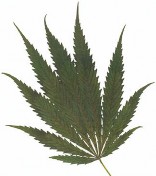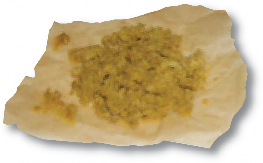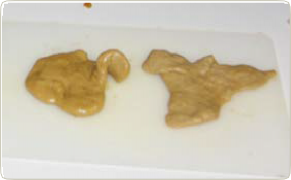3.9 Marijuana / Cannabis
WHAT IS MARIJUANA?
Marijuana is a mind-altering (psychoactive) drug, produced by the Cannabis sativa plant. Marijuana contains over 480 constituents. THC (delta-9-tetrahydrocannabinol) is believed to be the main ingredient that produces the psychoactive effect.
WHAT IS ITS ORIGIN?
Marijuana is grown in the United States, Canada, Mexico, South America, the Caribbean, and Asia. It can be cultivated in both outdoor and indoor settings.
What are common street names?
Common street names include: Aunt Mary, BC Bud, Blunts, Boom, Chronic, Dope, Gangster, Ganja, Grass, Hash, Herb, Hydro, Indo, Joint, Kif, Mary Jane, Mota, Pot, Reefer, Sinsemilla, Skunk, Smoke, Weed, and Yerba.
What does it look like?
Marijuana is a dry, shredded green/brown mix of flowers, stems, seeds, and leaves from the Cannabis sativa plant. The mixture typically is green, brown, or gray in color and may resemble tobacco.

How is it abused?
Marijuana is usually smoked as a cigarette (called a joint) or in a pipe or bong. It is also smoked in blunts, which are cigars that have been emptied of tobacco and refilled with marijuana, sometimes in combination with another drug. Marijuana is also mixed with foods or brewed as a tea.
What is its effect on the mind?
When marijuana is smoked, the THC passes from the lungs and into the bloodstream, which carries the chemical to the organs throughout the body, including the brain. In the brain, the THC connects to specific sites called cannabinoid receptors on nerve cells and influences the activity of those cells.
Many of these receptors are found in the parts of the brain that influence pleasure, memory, thought, concentration, sensory and time perception, and coordinated movement.
The short-term effects of marijuana include:
Problems with memory and learning, distorted perception, difficulty in thinking and problem-solving, and loss of coordination.
The effect of marijuana on perception and coordination are responsible for serious impairments in learning, associative processes, and psychomotor behavior (driving abilities). Long-term, regular use can lead to physical dependence and withdrawal following discontinuation, as well as psychic addiction or dependence. Clinical studies show that the physiological, psychological, and behavioral effects of marijuana vary among individuals and present a list of common responses to cannabinoids, as described in the scientific literature:
• Dizziness, nausea, tachycardia, facial flushing, dry mouth, and tremor initially
• Merriment, happiness, and even exhilaration at high doses
• Disinhibition, relaxation, increased sociability, and talkativeness
• Enhanced sensory perception, giving rise to increased appreciation of music, art, and touch Heightened imagination leading to a subjective sense of increased creativity
• Time distortions
• Illusions, delusions, and hallucinations are rare except at high doses
• Impaired judgment, reduced coordination, and ataxia, which can impede driving ability or lead to an increase in risktaking
behavior
• Emotional lability, the incongruity of affect, dysphoria, disorganized thinking, inability to converse logically, agitation, paranoia, confusion, restlessness, anxiety, drowsiness, and panic attacks may occur, especially in inexperienced users or in those who have taken a large dose
• Increased appetite and short-term memory impairment are common
What is its effect on the body?
Short-term physical effects from marijuana use may include sedation, bloodshot eyes, increased heart rate, coughing from lung irritation, increased appetite, and decreased blood pressure. Marijuana smokers experience serious health problems such as bronchitis, emphysema, and bronchial asthma. Extended use may cause suppression of the immune system. Withdrawal from chronic use of high doses of marijuana causes physical signs including a headache, shakiness, sweating, and stomach pains and nausea. Withdrawal symptoms also include behavioral signs such as restlessness, irritability, sleep difficulties, and decreased appetite.
What are its overdose effects?
No deaths from overdose of marijuana have been reported.
Which drugs cause similar effects?
Hashish and hashish oil are drugs made from the cannabis plant that is like marijuana, only stronger. Hashish (hash) consists of the THC-rich resinous material of the cannabis plant, which is collected, dried, and then compressed into a variety of forms, such as balls, cakes, or cookie-like sheets. Pieces are then broken off, placed in pipes or mixed with tobacco and placed in pipes or cigarettes, and smoked. The main sources of hashish are the Middle East, North Africa, Pakistan, and Afghanistan. Hashish Oil (hash oil, liquid hash, cannabis oil) is produced by extracting the cannabinoids from the plant material with a solvent. The color and odor of the extract will vary, depending on the solvent used. A drop or two of this liquid on a cigarette is equal to a single marijuana joint. Like marijuana, hashish and hashish oil are both Schedule I drugs.
What is its legal status in the United States?
Marijuana is a Schedule I substance under the Controlled Substances Act, meaning that it has a high potential for abuse, no currently accepted medical use in treatment in the United States, and a lack of accepted safety for use under medical supervision.
Although some states within the United States have allowed the use of marijuana for medicinal purpose, it is the U.S. Food and Drug Administration that has the federal authority to approve drugs for medicinal use in the U.S. To date, the FDA has not approved a marketing application for any marijuana product for any clinical indication. Consistent therewith, the FDA and DEA have concluded that marijuana has no federally approved medical use for treatment in the U.S. and thus it remains as a Schedule I controlled substance under federal law.
Marinol, a synthetic version of THC, the active ingredient found in the marijuana plant, can be prescribed for the control of nausea and vomiting caused by chemotherapeutic agents used in the treatment of cancer and to stimulate appetite in AIDS patients. Marinol is a Schedule III substance under the Controlled Substances Act.
Marijuana Concentrates Also Known As: THC Extractions
WHAT ARE MARIJUANA CONCENTRATES?
A marijuana concentrate is a highly potent THC concentrated mass that is most similar in appearance to either honey or butter, which is why it is referred to or known on the street as “honey oil” or “budder”.
WHAT IS ITS ORIGIN?
Marijuana concentrates contain extraordinarily high THC levels that could range from 40 to 80 percent. This form of marijuana can be up to four times stronger in THC content than high grade or top-shelf marijuana, which normally measures around 20 percent THC levels. Many methods are utilized to convert or “manufacture” marijuana into marijuana concentrates. One method is the butane extraction process. This process is particularly dangerous because it uses highly flammable butane to extract the THC from the cannabis plant. Given the extremely volatile nature of butane, this process has resulted in violent explosions. THC extraction labs are being reported nationwide, particularly in the western states and in states where local and state marijuana laws are more relaxed.
What are common street names?
Common street names include: 710 (the word “OIL” flipped and spelled backwards), wax, ear wax, honey oil, budder, butane hash oil, butane honey oil (BHO), shatter, dabs (dabbing), black glass, and errl.
What does it look like?
Marijuana concentrates are similar in appearance to honey or butter and are either brown or gold in color.


How is it abused?
One form of abuse occurs orally by infusing marijuana concentrates in various food or drink products; however, smoking remains the most popular form of ingestion by use of water or oil pipes. A disturbing aspect of this emerging threat is the ingestion of concentrates via electronic cigarettes (also known as e-cigarettes) or vaporizers. Many users of marijuana concentrates prefer the e-cigarette/vaporizer because it’s smokeless, odorless, and easy to hide or conceal. The user takes a small amount of marijuana concentrate, referred to as a “dab,” then heats the substance using the e-cigarette/vaporizer producing vapors that ensure an instant “high” effect upon the user. Using an e-cigarette/vaporizer to ingest marijuana concentrates is commonly referred to as “dabbing” or “vaping”.
What are the Effects of Using Marijuana Concentrates?
Being a highly concentrated form of marijuana, the effects upon the user may be more psychologically and physically intense than plant marijuana use. To date, long-term effects of marijuana concentrate use are not yet fully known; but, the effects of plant marijuana use are known. These effects include paranoia, anxiety, panic attacks, and hallucinations. Additionally, the use of plant marijuana increases one’s heart rate and blood pressure. Plant marijuana users may also experience withdrawal and addiction problems.
Source: Drugs of abuse: A DEA resource guide (DEA, 2017)
Additional information: National Institute on Drug Abuse (NIDA), Cannabis (Marijuana).
Assignment films and discussion boards are part of the policy chapter. Recently, I watched the marijuana episode the one Netflix series “Explained” which I found interesting and useful. Here is some information on this episode: Vox, The world’s weed market is rapidly changing. Most people have no idea what they’re buying.

